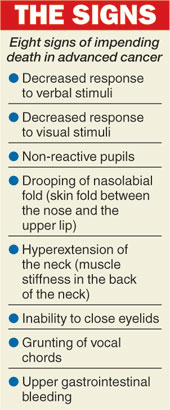
New Delhi, Feb. 9: Doctors have identified eight telltale signs that appear to portend the imminent death of patients with advanced cancer through a study whose findings they say could help patients, their families and doctors struggling with end-stage cancer.
The emergence of any one or some combination of these eight clinical signs in patients with advanced cancer suggests they are likely to die within three days, a team of doctors and health researchers in the US and Brazil said. Seven of the eight signs indicate deteriorating brain functions. (See chart)
While many doctors have earlier anecdotally documented each of these signs in patients close to death, this is the first study to systematically track the onset and frequencies of the signs in well-defined groups of patients.
The researchers said the ability to diagnose impending death would allow doctors to maximise the quality of life of the patients, withhold unnecessary diagnosis and medications, and inform family members about the approaching death with greater confidence than possible now.
"Family members equipped with such information may have a greater sense of control during this difficult time of uncertainty and sadness," David Hui, assistant professor of palliative care at the University of Texas MD Anderson Cancer Center who led the study, told The Telegraph.
Critical care and palliative medicine specialists here say the findings would also be relevant to India where anecdotal accounts suggest that many patients with end-stage cancer do not receive the ideal clinical management that they should as they approach death.
"In some settings, patients receive high-cost investigations and medical intervention even to the last day," said Geeta Joshi, a pain and palliative medicine specialist at the Gujarat Cancer and Research Institute, Ahmedabad.
"When such interventions are futile, they cause financial and mental stress on patients, and may raise false hopes where there should be none," said Joshi, who was not associated with the US study.
Hui and his colleagues examined 52 clinical signs every 12 hours in 253 among 357 patients with advanced cancer who died in hospitals in the US and Brazil and found that the emergence of any of the eight specific signs - easy to recognise at the bedside -were linked to death within 72 hours.
The eight signs are decreased response to verbal stimuli, decreased response to visual stimuli, non-reactive pupils, drooping of the naso-labial fold (the fold of skin between the nose and the upper lip), hyperextension of the neck (muscle stiffness at the back of the neck), an inability to close the eyelids, grunting of vocal chords and upper gastrointestinal bleeding.
The study, published today in the journal Cancer, suggests that the process of dying is associated with a progressive decline in brain functions as all the signs except upper gastrointestinal bleeding result from neurological dysfunctions.
The researchers say the findings, although significant, should be considered preliminary because of the small sample of patients. "We'll need more research to validate the results, particularly in non-cancer patients," Hui said.
The study suggests that a patient with any of the telltale signs has a high chance of dying within three days. Future research, Hui said, will also seek to determine whether the number of signs is associated with the length of survival - would a larger number of signs mean faster death?
"This is an important study - for it helps build evidence for palliative care decisions," said Dhruva Chaudhry, a critical care medicine specialist at the Postgraduate Institute of Medical Sciences, Rohtak. "Each of the signs is easy to detect at the bedside and does not require sophisticated gadgetry or diagnosis. Doctors can prepare families, which is an important component of palliative care medicine," he said.
Palliative care experts say the practice of palliative care remains poor as doctors are primarily trained to diagnose, treat and cure. Fewer than 10,000 of the estimated one million patients who die of cancer in India each year, Joshi said, receive effective palliative care during the end-stage of the disease.
"The adoption of such predictive signals in palliative care would help families and doctors take better-informed decisions about treatment and discharge options," said Praveen Khilnani, an intensive care unit specialist in New Delhi, and vice-president of the Indian Society for Critical Care Medicine.
The US researchers had last year identified pulselessness in the radial artery, breathing patterns and the death rattle - sounds produced by accumulated saliva and bronchial secretions in the throat - as indicators of imminent death.
In the new study, they screened 52 additional signs, including decreased speech, delirium, incontinence, purposeless movement and skin temperature among others. The eight signs they selected had the strongest correlation with imminent death.

